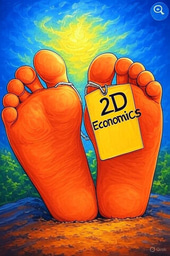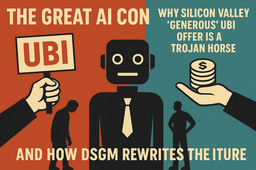Beyond the Hype: AlterEgo, AI, and the Rise of the 3D Economy
Published in Electrical & Electronic Engineering, Behavioural Sciences & Psychology, and Arts & Humanities

We’ve all felt it. That uncanny moment when an ad appears for exactly the thing you were just talking about. We chalk it up to coincidence or casual surveillance. But the truth is far more profound. We are witnessing the birth of a new human-computer interface, and it’s not a screen or a speaker—it’s your own mind.
The blueprint was laid out years ago. Remember MIT’s AlterEgo project (circa 2018)? A device that read neuromuscular signals from your jaw to interpret subvocalized thoughts and answer via bone conduction. It promised seamless, silent communication with AI. The tech world marveled at the hardware, but mostly missed the deeper implication: the creation of a perfect, frictionless channel between human intent and machine intelligence.
Fast forward to today. While we don’t wear AlterEgo headsets (yet), the AI "brain" for that interface is already built, live, and operational. It lives in the algorithms of Google, Meta, TikTok, and the global ad-tech ecosystem. Our smartphones are the proxy interface—constantly listening, watching, and inferring.
This system doesn't just track what we buy; it reverse-engineers our psychology. It maps our desires, fears, and aspirations with terrifying accuracy. Its goal? To shape behavior. To close the loop between a latent need and a purchase with flawless efficiency. This is the pinnacle of the old 2D Economy: a flat, extractive model focused on infinite growth on a finite platform (attention), measured purely by clicks, conversion, and consumption.
The Progress is Undeniable. The Downside is Unacceptable.
The power of this AI is incredible. It can recommend life-changing books, connect us with communities, and streamline our lives.
But the downside is a future we must avoid:
The Manipulation Economy: Our autonomy is eroded as choices are subtly guided by algorithms optimized for engagement and profit, not our well-being.
Cognitive Overload: The constant, seamless stream of suggestions creates noise, not clarity. It fragments our attention and overwhelms our cognitive capacity.
Extractive Data Practices: Our attention and personal data are treated as a non-renewable resource to be mined and depleted for short-term gain.
Digital Enslavement: Instead of AI working for us, we become the product, our behaviors farmed for the benefit of a few platforms.
This path is unsustainable. It leads to burnout, mistrust, and a depleted digital ecosystem. We need a new model.
Introducing the Symbiotic Model: From Extraction to Cultivation
We must evolve from a parasitic relationship with technology to a symbiotic one. This means building systems where human and machine intelligence grow together, where value is created mutually and sustainably.
The key to this is the Digital Sustainable Growth Factor – a new core metric for the 3D Economy.
In the 2D Economy, growth is flat: more data in, more products out. The 3D Economy is digital-native and multidimensional. Its growth isn't just about transaction volume; it's about the depth and quality of the interaction. The Growth Factor measures:
User Cognition & Skill Acquisition: Is the AI making me smarter, more skilled, or more creative?
Well-being & Digital Health: Is this interaction reducing my stress or contributing to it? Is it adding to my life or cluttering it?
Value Co-creation: Am I being treated as a data point, or as a partner in creating value? (e.g., AI that helps a designer iterate, rather than just pushing them to buy new software).
The 3D Economy: A Determinant for Abundance
This shift changes everything. Abundance in the 3D Economy isn't defined by the abundance of stuff for sale, but by the abundance of agency, time, creativity, and well-being for the user.
Imagine an AI interface built on this principle:
-
Instead of suggesting another video to mindlessly watch, it synthesizes the key insights from three long-form articles and offers to recite them to you on your walk, saving you hours.
-
Instead of pushing you to buy a new tool, it analyzes your work habits and proactively teaches you a keyboard shortcut that saves 5 minutes a day.
-
It protects your attention as a sacred resource, filtering noise and only allowing through what truly serves your goals.
This AI isn’t extracting value; it’s investing in your human capital. It measures its success by your success. This is a future of prosperity defined not by what we consume, but by what we create and who we become.
The technology is inevitable. The outcome is not.
References:
- Shalaby, A. The end of labor economics as we know it: DSGM and the shift to a 3D economy- a case study of Denmark’s transformation into a talent stock market. Digit. Econ. Sustain. Dev. 3, 17 (2025). https://doi.org/10.1007/s44265-025-00066-5
- Shalaby, A. (2024a). New Model for Digital Sustainable Growth: Insights from Human Biology and Surgical Approach – A Retrospective Analysis of 15 Years of Socio-Economic Innovations at the Human Information Technology Lab, Finland. DESD, 2, 14. DOI: 1007/s44265-024-00038-1
- Shalaby, Ahmed, The 2D Economy Is a Dead Horse-The Digital Sustainable Growth Model is Disrupting the Traditional Macro-Microeconomics in the 3D Economy (February 03, 2025). Available at http://dx.doi.org/10.2139/ssrn.5160079
- Shalaby, A. (2024b). Digital Sustainable Growth Model (DSGM): Achieving Synergy Between Economy and Technology to Mitigate AGI Risks and Address Global Debt Challenges. Journal of Economy and Technology. Available online 16 August 2024. DOI: 1016/j.ject.2024.08.003
- Shalaby, A. (2024c). Classification for Digital and Cognitive AI Hazards: Urgent Call to Establish Automated Safe Standards for Protecting Young Human Minds. DESD, 2, 17. DOI: 1007/s44265-024-00042-5
- Shalaby, A. (2024d). Leveraging the Digital Sustainable Growth Model (DSGM) to Drive Economic Growth: Transforming Innovation Uncertainty into Scalable Technology. Journal of Economy and Technology. DOI: 1016/j.ject.2024.09.003
- Shalaby, A. (2024e). Moving Beyond the Old Economic Models – A Response to Daron Acemoglu’s ‘The Simple Macroeconomics of AI’. SSRN: https://ssrn.com/abstract=5077217






Please sign in or register for FREE
If you are a registered user on Research Communities by Springer Nature, please sign in